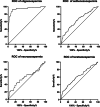Semen parameters are seriously affected in acephalic spermatozoa syndrome
- PMID: 36028792
- PMCID: PMC9413908
- DOI: 10.1186/s12610-022-00170-y
Semen parameters are seriously affected in acephalic spermatozoa syndrome
Abstract
Background: Previous studies have reported that some patients with headless spermatozoa have poor semen quality, but there has been no published systematic analysis of semen quality in patients with different proportions of headless spermatozoa in semen. We aimed to explore the association of acephalic spermatozoa syndrome and semen quality in men with distinct proportions of headless spermatozoa.
Material and methods: Semen parameter values in patients for whom headless spermatozoa were found in the ejaculates was studied and compared to that of 413 age-matched prenatal examination patients. All semen samples were analyzed following the same methodology in a single laboratory.
Results: All semen parameter values except semen volume were negatively (P < 0.05) correlated with the proportion of headless spermatozoa. The semen samples were divided into four groups on the basis of the proportion of headless spermatozoa (PHS) as follows: 0 < PHS ≤ 5% (n = 172, Group A1); 5 < PHS ≤ 10% (n = 76, Group A2); 10 < PHS ≤ 20% (n = 71, Group B); and PHS > 20% (n = 71, Group C). In Group A1, only one semen parameter value (progressive motility) was lower than those of the control group, but in Group A2, this increased to five (sperm vitality, normal sperm morphology, sperm motility, VCL (curvilinear velocity) and ALH (amplitude of lateral head displacement)). Worse still, all semen parameter values were significantly lower in Group B and Group C than in the control group (P < 0.05).
Conclusions: Semen samples containing headless spermatozoa tend to have lower quality than samples without headless spermatozoa. Increases in the proportion of headless spermatozoa in semen are associated with decreased semen quality. We suggest that headless spermatozoa should be seriously assessed and accurately counted in semen analysis, especially for ejaculate in which the proportion of headless spermatozoa exceeds 5%.
RéSUMé: CONTEXTE: Des études antérieures ont rapporté que certains patients qui avaient des spermatozoïdes sans tête présentaient une mauvaise qualité du sperme, mais il n’y a eu aucune analyse systématique publiée sur la qualité du sperme chez les patients ayant des proportions différentes de spermatozoïdes sans tête dans leur sperme. Nous avons cherché à explorer l’association entre syndrome des spermatozoïdes acéphaliques et qualité du sperme chez les hommes ayant des proportions distinctes de spermatozoïdes sans tête. Les valeurs des paramètres du sperme chez les patients pour lesquels des spermatozoïdes sans tête ont été trouvés dans l’éjaculat ont été étudiées et comparées à celles de 413 patients consultant pour un examen prénatal, appariés sur l’âge. Tous les échantillons de sperme ont été analysés selon la même méthodologie dans un seul laboratoire. RéSULTATS: Toutes les valeurs des paramètres du sperme, à l’exception du volume de sperme, étaient négativement (P < 0,05) corrélées avec la proportion de spermatozoïdes sans tête. Les échantillons de sperme ont été divisés en quatre groupes sur la base de la proportion de spermatozoïdes sans tête (PHS) comme suit: 0 < PHS ≤ 5% (n = 172, groupe A1); 5 < PHS ≤ 10% (n = 76, groupe A2); 10 < PHS ≤ 20% (n = 71, groupe B); et PHS > 20% (n = 71, groupe C). Dans le groupe A1, une seule valeur de paramètre de sperme (motilité progressive) est. inférieure à celle du groupe témoin, mais dans le groupe A2, le nombre s’élève à cinq (vitalité des spermatozoïdes, morphologie normale des spermatozoïdes, mobilité des spermatozoïdes, VCL (vitesse linéaire curviligne) et ALH (amplitude du déplacement latéral de la tête)). Pire encore, toutes les valeurs des paramètres du sperme étaient significativement plus faibles dans les groupes B et C que dans le groupe témoin (P < 0,05). CONCLUSIONS: Les échantillons de sperme contenant des spermatozoïdes sans tête ont tendance à avoir une qualité inférieure à celle des échantillons dépourvus de spermatozoïdes sans tête. L’augmentation de la proportion de spermatozoïdes sans tête dans le sperme est. associée à une réduction de la qualité du sperme. Nous suggérons que les spermatozoïdes sans tête devraient être sérieusement évalués et comptés avec précision dans l’analyse du sperme, en particulier pour l’éjaculat dans lequel la proportion de spermatozoïdes sans tête dépasse 5%.
© 2022. The Author(s).
Conflict of interest statement
The authors declare no competing interests.
Figures






References
LinkOut - more resources
Full Text Sources
Miscellaneous

